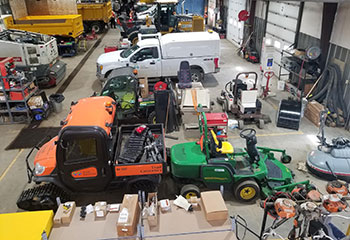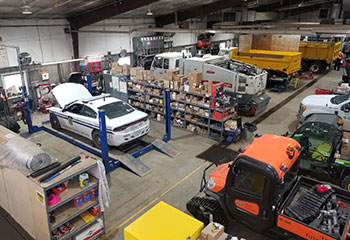
Summary
The City of North Battleford knew its too-large vehicle fleet was an opportunity to reduce both costs and emissions. It commissioned a study that analyzed municipal vehicle ownership and usage and made a series of recommendations to help the City save money and move closer to net-zero while continuing to meet the needs of users and residents.
Background

The City of North Battleford is located in west-central Saskatchewan along the North Saskatchewan river and is home to about 15,000 people. The City has long owned vehicles for municipal use, but staff realized that its fleet had grown in size while the number of users had not. They decided that assessing and then refining their municipal vehicle fleet was an opportunity to rein in costs while also reducing their carbon footprint and contributing toward the move to net-zero.
The challenge
With financial support from GMF, the City issued an RFP to study their fleet and determine how they could make it more efficient to lower costs and emissions while continuing to meet user needs and provide reliable service to residents. An additional goal was to explore the feasibility of using electric vehicles.
Approach

To complete the study, the City chose to work with Fleet Challenge Canada, an organization that specializes in optimizing vehicle fleets. Steps included:
- Data-gathering, review and analysis of the current fleet, its usage and costs, as well as of relevant city policies and protocols. This included surveying staff (vehicle users)
- Data analysis and modelling to forecast future fleet usage, operating costs and emissions impacts, and to optimize use of current vehicles versus purchasing new ones. The team also explored the relative costs of buying versus renting or leasing
- Assessment of current and future feasibility of bringing in electric or hybrid-electric vehicles as part of the municipal fleet, as well as a review of future charging infrastructure requirements
Results
The study concluded not only that the fleet was too large for North Battleford’s needs, but also that it was on average past its prime usable lifetime, and that the vehicles should be upgraded. Specific recommendations included:
Management:
- Reduce fleet size, beginning with vehicles that are under-utilized
- Invest in fleet management software to boost available data and help lower costs, for example by optimizing maintenance schedules
- Avoid excess costs and emissions by right-sizing fleet use (avoiding using larger vehicles on jobs that don’t require them), enforcing anti-idling policies and training staff to drive in a fuel-efficient manner
Purchasing:
- Modernize the fleet and consider leasing new vehicles as an interim measure to limit immediate capital costs
- Consider hybrid, biodiesel and electric vehicles (EVs) as solutions to lower costs and emissions during fleet modernization
- Make better use of capital by using total cost of ownership as a benchmark when purchasing new vehicles, rather than just upfront costs. For instance, vehicles with better fuel economy and fewer maintenance requirements have lower operational costs
- Invest in charging infrastructure in the short term to meet demand in the medium and long term, as better EVs become available on the market and more suitable for municipal needs
Benefits
North Battleford now has a clear understanding of the makeup of its vehicle fleet and the steps it can take to lower costs and emissions. In addition, its efforts to modernize the fleet and invest in charging infrastructure will benefit the community by demonstrating the feasibility of using EVs and hybrid vehicles in the region.
Lessons learned
One major realization during the study was how many gaps there were in the City’s record-keeping about its fleet, primarily in terms of historical information. They had to do additional research to compensate for a lack of knowledge. The better the historical data, the more accurate the study will be.
Next steps
Following the completion of the study, the City’s next step was to create an action plan to implement the recommendations. They recently purchased two new fleet vehicles, one hybrid and one plug-in hybrid, to replace half-ton trucks. The new vehicles are expected to reduce fuel costs by 20 to 30 percent and emissions by 40 to 50 percent.
Want to explore all GMF-funded projects? Check out the Projects Database for a complete overview of funded projects and get inspired by municipalities of all sizes, across Canada.

